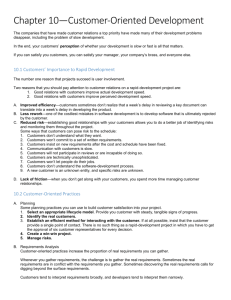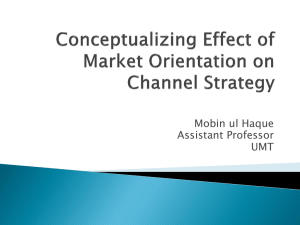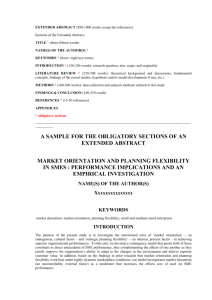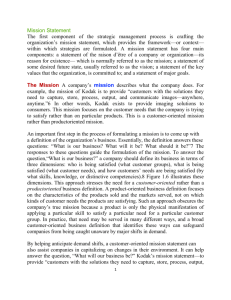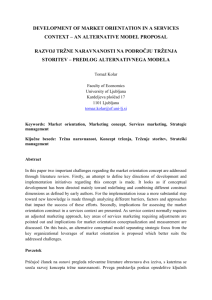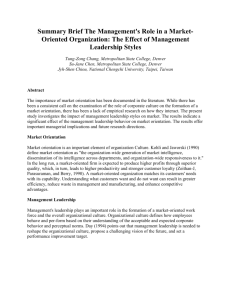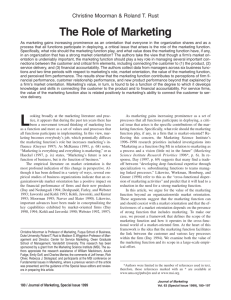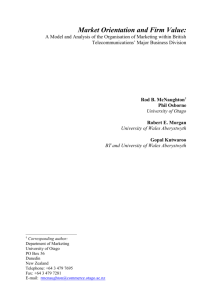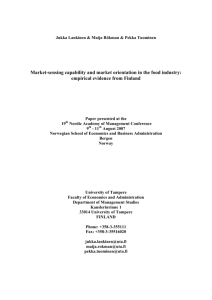Internal dynamics of customer-oriented service organizations
advertisement
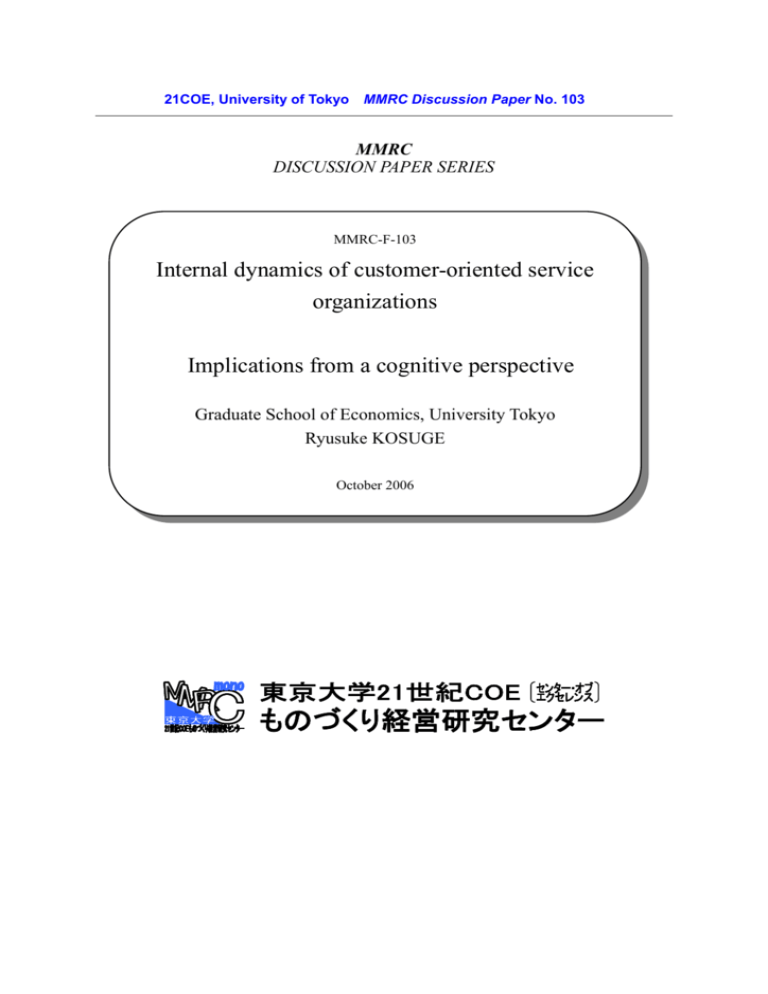
21COE, University of Tokyo MMRC Discussion Paper No. 103 MMRC DISCUSSION PAPER SERIES MMRC-F-103 Internal dynamics of customer-oriented service organizations Implications from a cognitive perspective Graduate School of Economics, University Tokyo Ryusuke KOSUGE October 2006 21COE, University MMRCDiscussion Discussion Paper 21COE, Universityof ofTokyo Tokyo MMRC Paper No.No. 103103 Internal dynamics of customer-oriented service organizations Implications from a cognitive perspective Graduate School of Economics, University of Tokyo Ryusuke KOSUGE October 2006 1 Ryusuke KOSUGE Abstract This paper tries to investigate the question of how an organization can be customer-oriented. Based on a critical examination of existing research that implicitly assumes cultural homogeneity, this paper views organizational culture as a varying degree of shared cognition among its organizational members and focuses on individual employee’s customer orientation. Based on a questionnaire survey of 425 employees within two financial service organizations, the degree of customer orientation was found to vary significantly within each organization according to the existence of customer contact. Further, structural equation modeling analyses indicated that customer contact leads to a positive attitude toward others within the organization, mediated by customer orientation. Combined with anecdotal evidence, these findings suggested a subculture formation process with respect to customer orientation. Finally, implications and directions for future research are discussed. Key words customer orientation, cognitive perspective, subculture formation 1. Introduction Customer orientation is often a taken-for-granted fundamental principle within the management practice. Managers give emphasis to “stay close to the customer” and to “put the customer at the top of the organizational chart” and consequently define the purpose of a business as the creation and retention of satisfied customers. Many firms, however, tend to fail to direct their businesses toward their customers. For managers in any type of businesses, developing a customer-oriented organization is always a big challenge. Since the late 1980s, marketing researchers have conducted a number of empirical studies concerning customer-oriented organization 1 in the name of “market orientation” (Kohli & Jaworski, 1990; Narver & Slater, 1990). These studies mainly focus on antecedents and consequences of a market orientation through cross-sectional surveys. Until now, however, only a few researches have empirically investigated the question of “how” a firm can actually be customer-oriented. This paper tries to answer this question from a cognitive perspective on organizational culture. Although researchers agree that market orientation is a kind of organizational culture (Day, 1994; Narver & Slater, 1990), 1 Hereafter, a “customer-oriented organization” is used to refer to an organization that embodies the marketing concept. 2 Internal dynamics of customer-oriented service organizations the extant conceptualizations of market orientation as an organizational culture are insufficient. In these conceptualizations, organizational culture is assumed to be homogeneous and unitary throughout the organization. By making such an assumption, existing research solely focuses on the abstract and aggregated organizational activities, and by so doing, neglecting the internal dimensions of a customer-oriented organization. This paper adopts a cognitive perspective on organizational culture in order to focus on potential heterogeneity among individuals and groups within a customer-oriented organization. The paper firstly identifies the research problems by critically reviewing prior research concerning customer–oriented organization and secondly presents the methodology of the study. Next, the empirical findings from an exploratory investigation of two financial service organizations are presented. Finally, the conclusions are presented by discussing implications and directions for future research. 2. Background Recent empirical research regarding customer-oriented organization has its origin in the management philosophy known as “the marketing concept” (Kohli & Jaworski, 1990). The marketing concept has been a cornerstone of the marketing discipline since Drucker (1954) argued that “[t]here is only one valid definition of business purpose: to create a customer” (p.37) and described marketing as “the whole business seen from customer’s point of view” (p.39). Throughout its history, however, the marketing concept has been more an article of faith than a practical basis for managing a business. Little was known about the defining features or attributes of this organizational orientation, and findings regarding the antecedents and performance consequences were mainly anecdotal. Consequently, managers had little guidance on how to improve or redirect their organizations toward their markets. In the 1980s, a renewed interest in the marketing concept was born (Webster, 1988). With the rise of Japanese businesses, the marketing concept was seen to be an organizational culture that would provide a competitive advantage (e.g., Peters & Waterman, 1982). In response, marketing researchers began to conceptualize the marketing concept more strictly. In the 1990s, two influential publications (Kohli & Jaworski, 1990; Narver & Slater, 1990) in the Journal of Marketing that originated from research sponsored by the MSI (Marketing Science Institute) founded the basis of a new era (Deshpande, 1999). Subsequent research has been using these publications as a point of reference and in the academic debate, the term “the marketing concept” has been replaced by the term “market orientation”. The market orientation research Kohli and Jaworski (1990) set out to understand the construct of market orientation by identifying and 3 Ryusuke KOSUGE defining its cause, components, and outcomes and consequently developed a set of testable propositions. They conceptualized market orientation as the implementation of the marketing concept and defined it as the (1) organization-wide generation of market intelligence pertaining to current and future customer needs, (2) dissemination of the intelligence across departments, and (3) organization-wide responsiveness to it. On the other hand, Narver and Slater (1990) defined market orientation as the organizational culture and climate that most effectively encourages the behaviors that are necessary for the creation of superior value for buyers, and thus, the continuous superior profit for the business. In addition, they also suggested that market orientation involves three behavioral components: customer orientation, competitor orientation, and interfunctional coordination. Each of these efforts have served to extend the marketing concept from being a purely business philosophy to representing the actions an organization pursue in relation to their marketplace. Two of the most used measures of market orientation are MKTOR, which is based on a cultural definition (Narver & Slater, 1990), and MARKOR, which is based on a behavioral definition (Kohli, Jaworski, & Kumar, 1993). Although there is a difference between the two definitions, both measurement scales focus largely on concrete activities. The unit of analysis of market orientation is the organization where single respondents are used to assess the degree of market orientation via Likert-type scales. Market orientation of a business or a firm is the simple average of the scores of these components. Most of the previous studies focus on the antecedents and consequences of a market orientation, as well as the variables that might moderate the relationships between market orientation and its consequences. Although recent findings are inconsistent regarding the relationship between market orientation and business performance, the dominant view is that market orientation does improve business performance (Deshpande, Farley, & Webster, 1993; Jaworski & Kohli, 1993; Narver & Slater, 1990). Studies including potential moderators, such as market turbulence, technological turbulence, and competitive intensity (Jaworski & Kohli, 1993; Slater & Narver, 1994), indicate that these moderators have little effect on the positive impact of market orientation on firm performance (Wrenn, 1997). Various antecedents have furthermore been proposed and empirically tested (Jaworski & Kohli, 1993; Ruekert, 1992). In particular, top management emphasis, interdepartmental connectedness, and human resource practices are found to positively related to market orientation. Problems of the market orientation research Based on the research described above, a number of empirical studies have been brought forth. Given the substantial amount of empirical findings suggesting a positive relationship between market orientation and firm performance, the logical next step would be to investigate how market orientation is developed. Existing 4 Internal dynamics of customer-oriented service organizations research, however, is only modestly descriptive of the processes for achieving this desired orientation. For instance, Day (1994) focuses on business process redesign, either radically or gradually from the bottom up, combined with top down signaling of commitment and stretching of improvement targets. In a similar fashion, Narver, Slater, and Tietje (1998) suggests two approaches for creating a market orientation that should be tailored and managed; the “programmatic” approach and the “market-back” approach. Few empirical studies have investigated the process of developing market orientation. It is only recently that, by using a paired-comparison ethnographic study, Kennedy, Goolsby, and Arnould (2003) clarified the roles of leadership, interfunctional coordination, and the processing of customer-focused data in the transformation process in a major public school district. One possible reason for the scarcity of empirical research on the process of developing market orientation is that the prevailing conceptualizations of market orientation may not be suited to investigate the “how” question. As indicated by the measurement method noted above, the market orientation stream of research assumes homogeneous responses to market and customers within an organization. By making such an assumption, existing research fails to provide context-specific guidance. To fully understand this point, the following section takes a close look at the organizational culture perspective on which existing research is based. Reexamining organizational culture perspectives Based on the original thought of Drucker (1954), Deshpande and Webster (1989) defined the marketing concept as a distinct organizational culture; a fundamental shared set of beliefs and values that put the customer in the center of the firm’s conception about strategy and operation. In accordance with this definition, there is considerable agreement that, in general, market orientation is an organizational culture (e.g., Narver & Slater, 1990: Day, 1994). The question is how existing research conceives the concept of organizational culture as the basis of market orientation. Although little attention has given to what an organizational culture is, the answer can be found in the way market orientation is treated within the extant research. Firstly, inferring form the single informant strategy, which assumes one senior executive is able to assess the degree of market orientation for the whole organization, organizational culture is viewed as homogeneous throughout the organization. Secondly, as Webster (1994) argues that market orientation consists of commitment of every employee within the organization, organizational culture is viewed as internally cohesive. Thirdly, as previously noted, market orientation is viewed as controllable by management actions (Day, 1994; Narver et al., 1998). In essence, this conception of organizational culture is grounded in structural-functionalism. In this perspective, organizational culture is seen as a latent variable endogenous to 5 Ryusuke KOSUGE the firm, consisting of beliefs and values developed by and within the organization (Smircich, 1983). Furthermore, based on a managerial biased assumption, organizational culture is viewed as a lever or a tool to be used by managers to shape performance outcomes (e.g., Deal & Kennedy, 1982; Peters & Waterman, 1982). Despite its intuitive understandability, this perspective is not necessary sufficient to reveal the breadth of organizational culture due to lack of analytical bites (Pettigrew, 1979). Specifically, the cultural change process is difficult to explain by this perspective. In order to investigate the “how” question, this paper introduces a cognitive perspective which emphasizes multicultural aspects within an organization. This organizational culture perspective focuses on the subjective beliefs that individual members share in varying degrees. According to Smircich (1983, p.350) this cognitive orientation provokes questions “…of practical concern to those who seek to understand, diagnose, and alter the way organization is working”. Further, in this perspective, one assumes “multiple organization subcultures, or even countercultures, competing to define the nature of situations within organizational boundaries” (Smircich, 1983, p.346). For example, Gregory (1983) criticized holistic view of organizational culture and proposed a multicultural model for large organizations by presenting multiple “native” views through an ethnographic study of Silicon Valley technical professionals. By adopting this cognitive perspective on organizational culture, a more thorough understanding can be acquired regarding the internal dimensions of a customer-oriented organization. While extant market orientation research has held the organization as the appropriate unit of analysis, this paper focuses on the individual employee’s “customer orientation” under the assumption that a customer-oriented organization is the one in which every employee is committed to the value creation for customers (Narver et al., 1998; Webster, 1994). Consistent with the perspective, “customer orientation” is reconceptualized as an individual-level construct; an individual cognitive tendency to meet expectations of customers from the customer’s point of view. Although this perspective is normally used within ethnography, this study applies it in a quantitative context. In the following section, the exploratory investigation using this perspective is presented. With this context-free construct, a questionnaire survey is used in order to cover every employee within the studied organizations, regardless of his or her type of job. This approach will provide new insight into how an organization can actually be customer-oriented. 3. The study In the study, data were collected from two financial service organizations within a big financial group. Individuals across the service organizations were considered as suitable units of analysis, since the role of each 6 Internal dynamics of customer-oriented service organizations individual in creating and delivering value for the customer is considered critical for the service organizations. The survey was conducted in September 2003. The questionnaire was completed by 251 respondents within Company A and 174 respondents within Company B, corresponding to a total response rate of 87 %. The self-administered questionnaire, which was written in Japanese, consisted of 60 yes-no questions regarding demographics, job attitudes including customer orientation, and perceived organizational climate. The yes-no answers were quantified and represented by dummy variables (1=yes 0=no). Determination of customer orientation Following the definition of customer orientation noted above, the study introduced five items as shown bellow. E1. I consciously know who the customer is. E2. I try to understand what the customer wants from the customer’s point of view. E3: The customer has the information I need to do a better job. E4: If I could learn more about our customer I could do a better job. E5: I would enjoy seeing how customers use our product and discussing it with them. E1 represents the consciousness of the customer. Depending on the context of the respondent’s job, the existence of the customer is not necessary obvious. Customer orientation is thus based on the employee’s conception of the customer. E2 represents adoption of customer’s perspective (Mead, 1934). As Drucker (1954) noted, the essence of the marketing concept is to take the customer’s point of view. E3, E4 and E5 were selected from previous studies (e.g., Allen, McQuarrie , & Barr, 1998; Saxe & Weitz, 1982). As a first step in the analysis, the degree of aggregated customer orientation was calculated for Company A and Company B respectively. Given that organizational culture is a variable endogenous to the company and functioning cohesively, the degree of customer orientation is expected to differ by company. 7 Ryusuke KOSUGE Figure 1: Comparison of customer orientation: A and B yes ratio (%) 100 80 60 Company A Company B 40 20 0 E1 E2 E3 E4 E5 The result is shown in Figure 1. Company A was found to show higher degree of customer orientation as compared with Company B. Based on a 2×2 cross tabulation (yes/no; Company A/B), Pearson’s chi-square statistics and correlation coefficient was calculated for each question. As a result, positive correlation was found at the 1% statistical significance level. For each question, χ² and correlation coefficient were as follows: E1: 17.80/0.20, E2: 10.91/0.16, E3: 11.755/0.16, E4: 18.48/0.21, E5: 10.85/0.16. From the result, it is likely that the degree of customer orientation is determined by the company. However, these two companies share similar norms regarding customer-related activities. For example, they share customer voices, market-based personnel evaluation, and training for building the corporate brand. Therefore, it seems necessary to investigate the determinants of customer orientation more closely by focusing on the internal dimensions of organizational culture. Looking into the structural aspects of both companies, difference within the scope of customer contact is identified. Within Company A, almost all employees seem to have contact with the customer in contrast to only a portion of the employees within Company B. To examine this point in detail, employees within Company B were divided into “customer contact workers” and “non-customer contact workers” according to the following question. C1. In my job, it is necessary to have direct contact with customers. 8 Internal dynamics of customer-oriented service organizations Figure 2: Comparison of customer orientation: Customer contact and non-customer contact yes ratio (%) 100 Company A 80 Company B customer contact Company B non customer contact 60 40 20 0 E1 E2 E3 E4 E5 As a result, only 63.8% of the employees within Company B were found to have direct contact with the customers, as compared with 96.4% of the employees within A. The Degree of customer orientation was then compared according to the existence of customer contact. Figure 2 indicates that the non-customer contact employees within Company B showed remarkably low degree of customer orientation, while customer contact employees within Company B showed as high degree as employees within Company A. Based on the findings above, the following hypothesis is generated: Hypothesis (1) customer orientation is positively related to customer contact. To test the hypothesis, the correlation between customer orientation and customer contact was investigated. As a result, positive correlation was found at the 1% statistical significance level. For each question, χ² and correlation coefficient were as follows: E1: 82.67/0.44, E2: 763.37/0.42, E3: 40.41/0.31, E4: 63.558/0.38, E5: 60.96/0.37. The positive impact of customer contact on customer orientation was remarkable compared with other organizational and individual factors. For example, in contrast with previous studies (e.g., Siguaw, Brown, & Widing, 1994), business’s perceived orientation toward its customers correlated only weakly with customer orientation 2 . 2 The correlation between the question “Our business exists primary to serve its customers” and E1 was 0.17. 9 Ryusuke KOSUGE In addition, sex, age, tenure, and hierarchical position were not significantly correlated with customer orientation. In summary, these findings indicated that the degree of customer orientation is not unitary throughout the organization and is determined especially by customer contact. Influence process of customer orientation The finding that customer contact employees are highly customer oriented can be explained by the concept of cognitive coupling (Adams, 1976; Weick, 1979) between contact employee and the customer. Another explanation for this fact is that there are interpersonal influence processes among contact employees. For example, Hartline, Maxham III, and McKee (2000) indicate that customer orientation prevails through the socialization process within a workgroup. It is reasonable to infer that such an influence process is based on positive attitudes and behaviors of employees. On this point, service marketing literature suggests that customer-oriented employees show positive attitudes or behaviors to the organization and others within the organization in order to ultimately satisfy customers; that is, customer-oriented employees recognize that for successful exchange with customers occur, effective internal exchange must occur first (Ballantyne, 1997; Donavan, Brown, & Mowen, 2004). Accordingly, attitudinal and behavioral factors that seemed to be associated with customer orientation were investigated. Factor analysis of the data showed that customer orientation was associated with the following factor consisting of three questionnaire items (I1-I3). This factor was labeled as “others-orientation”. The finding is equivalent to the hypothesis presented below. I1. I do my work regardless of the section in a proactive manner. I2. I am confident that I can persuade someone to do something that I think is good. I3. Depending on the kind of the problem, I should take the initiative and exercise leadership to solve the problem. Hypothesis (2) Customer orientation is positively related to others-orientation. Combining Hypothesis (1) with (2), a causal model is suggested. To examine the validity of the model, a structural equation modeling (Kano & Miura, 2002; Loehlin, 2004) was used, through application of Amos 5.0. As observed variables corresponding to customer orientation, question E1, E2, and E3 were developed. E4 and E5 were not appropriate with respect to the statistical requirements. As observed variables corresponding to others-orientation, I1, I2, and I3 were adopted. 10 Internal dynamics of customer-oriented service organizations Causal models for Company A and Company B are shown in Figure 3 and Figure 4 respectively. The test results indicate a high P-value. As shown in the figures, fit index for each model was good. Standardized path coefficients between latent variables and observed variables, and between customer contact, customer orientation, and others-orientation were statistically significant at the 5 % level. Despite the difference in the nature of customer contact (Kellog & Chase, 1995), identical causal model was suggested. The results show that customer contact leads to customer orientation, and then others-orientation. Figure 3: Covariance structure model of Company A e1 e2 e3 E1 E2 E3 .87 Customer Contact .24 .69 .33 Customer Orientation ƒÄ1 .59 .50 Others Orientation .54 I1 e4 I2 e5 I3 e6 .41 ƒÄ2 11 Ryusuke KOSUGE Figure 4: Covariance structure model of Company B e1 e2 e3 E1 E2 E3 .78 Customer Contact .63 .85 .53 Customer Orientation ƒÄ1 .77 .49 Others Orientation .53 I1 e4 I2 e5 I3 e6 .62 ƒÄ2 According to this causal model, customer orientation may be developed throughout the organization by the influence of customer contact employee’s behavior. Inferring from the low degree of customer orientation, non-customer contact employees within Company B may nevertheless be left outside the influence process originating from customer contact. There are two possible explanations for this point. Firstly, others-orientation may be an attitudinal factor that does not accompany concrete behaviors toward others outside the sections. In fact, although question I1 represents a cross-boundary behavior within the organization, the more concrete corresponding questions were not significantly correlated with customer orientation 3 . Secondly, non-customer contact employees within Company B may tend to take inward attitudes. An informal interview with top managers confirmed this point; non-customer contact employees tended to act on their own accords, not trying to cooperate with others outside the section. According to the managers, successful product development was hindered by the failure of interdepartmental cooperation. To sum up, customer orientation is suggested to pervade the organization through the interpersonal influence process among employees. This kind of influence process can be viewed as a formation process of subcultures. According to the literature, subcultures are formed based on the interactions among organizational members who share common problems or situations (Lawrence & Lorsch, 1967; Van Maanen & Barley, 1984). 3 The correlation between the question “I sometimes help someone outside the section with his or her job” and E1 was 0.14. Similarly, the correlation between the question “I sometimes help my colleagues or subordinates with their extra work” and E1 was 0.15. 12 Internal dynamics of customer-oriented service organizations In the context of this study, subculture with respect to customer orientation may be developed primary through the sharing of local customer contact. 4. Conclusion Based on a cognitive perspective on organizational culture, this study explored the internal dimensions of customer-oriented organizations by focusing on single individual’s cognitive customer orientation within two service organizations. Findings from this research are summarized as follows. Firstly, the degree of customer orienation is not unitary wihin each organization and is determined by the existence of local customer contact. Secondly, customer orientation is positively related to others-orientation within the organzation. Combined with anecdotal evidence, it was suggested that customer orientation is amplified within a work unit through the interpersonal influence process, resulting in the formation of subcultures. These findings provide managerial and theoretical implications. Firstly, the finding suggests that organizational culture with respect to customer orientation is developed through an organizational learning process originating from customer contact. This process is consistent with the “market-back” approach which Narver et al. (1998) presented. Given that cultural change can occur naturally among employees, managers who are concerned with developing a customer-oriented organization should encourage employees to have contact with the customers and promote experimental learning. Secondly, heterogeneous responses toward the customer suggest that the underlying assumption of existing research, i.e. organizational culture is homogeneous and unitary, is overly simplistic. This implies that measuring “market orientation” through the assessment by single respondents may be insufficient or inappropriate for investigating the link with firm performance. Researchers should not neglect the multiple roles of individuals and groups within an organization because they are the basis f customer-oriented activities. Limitations and directions for furture reseach A limitaton of this research is that the study did not comprehensively investigate confounding factors that might affect customer orientation. Further research should introduce other potential factors and refine the causal model. This study may also be limited by the obtained samples. Additional studies might investigate employees within various types of organizations and industries in order to determine whether the same causal relationship holds. Another important area for further research involves how the influence process as shown above really works. Dougherty (1992) suggests that different “departmental thought worlds” including view of customers tend to hinder successful product innovation and argued that sharing a realistic customer focus may overcome 13 Ryusuke KOSUGE such a failure of cooperation. By investigating multiple thought worlds regarding view of customers and how they would be reconciled, we may more fully understand the process of developing a customer-oriented organization. In summary, the analytical viewpoint and the findings presented in this paper will contribute to a more thorough understanding of how a firm can actually be customer-oriented. Appendix Company A:Mean, standard deviation, and correlation of two variables SD 0.19 C C Mean 0.96 E1 0.93 0.25 0.20 E2 0.81 0.26 0.20 0.60 E3 0.96 0.39 0.12 0.27 0.26 I1 0.68 0.47 0.05 0.26 0.20 0.12 I2 0.63 0.48 -0.02 0.29 0.20 0.05 0.28 I3 0.75 0.43 0.09 0.25 0.12 0.12 0.19 E1 E2 E3 I1 I2 0.22 N =251 Company B:Mean, standard deviation, and correlation of two variables SD 0.48 C C Mean 0.64 E1 0.80 0.40 0.49 E2 0.83 0.38 0.51 0.68 E3 0.66 0.48 0.37 0.34 0.48 I1 0.71 0.45 0.34 0.28 0.28 0.32 I2 0.55 0.50 0.24 0.36 0.32 0.21 0.25 I3 0.86 0.35 0.36 0.34 0.39 0.28 0.30 E1 E2 E3 I1 I2 0.34 N =174 References Adams, J. S. (1976). The structure and dynamics of behaviour in organizational boundary roles. In M. D. Dunnette (Ed.), Handbook of industrial and organizational psychology (pp. 1175-1199). Chicago: Rand McNally. Allen C. T., McQuarrie, E. F., & Barr, T. F. (1998). Implementing the marketing concept one employee at a time: Pinpointing beliefs about customer focus as a lever for organizational renewal. Journal of Market 14 Internal dynamics of customer-oriented service organizations -Focused Management, 3, 151-170. Ballantyne, D. (1997). Internal networks for internal Marketing. Journal of Marketing Management, 13(5), 343-347. Day, G. S. (1994). The capabilities of market-driven organizations. Journal of Marketing, 58(4), 37-52. Deal, T. E., & Kennedy, A. E. (1982). Corporate cultures. Cambridge, MA: Ballinger. Deshpande, R. (Ed.). (1999). Developing a market orientation. Thousand Oaks, CA: Sage. Deshpande, R., Farley, J. U., & Webster, F. E., Jr. (1993). Corporate culture, customer orientation, and innovativeness in Japanese firms: A quadrad analysis. Journal of Marketing, 57(1), 23-37. Deshpande, R., & Webster, F. E., Jr. (1989). Organizational culture and marketing: Defining the research agenda. Journal of Marketing, 53(1), 3-15. Donavan, D. T., Brown, T. J., & Mowen, J. C. (2004). Internal benefits of service-worker customer orientation: Job satisfaction, commitment, and organizational citizenship behaviors. Journal of Marketing, 68(1), 128-146. Dougherty, D. (1992). Interpretive barriers to successful product innovation in large firms. Organization Science, 3(2), 179-202. Drucker, P. F. (1954). The practice of management. New York: Harper & Row. Gregory, K. L. (1983). Native-view paradigms: Multiple cultures and culture conflicts in organizations. Administrative Science Quarterly, 28, 359-376. Jaworski, B. J., & Kohli, A. K. (1993). Market orientation: Antecedents and consequences. Journal of Marketing, 57(3), 53-70. Hartline, M. D., Maxham III, J. G. & McKee, D. O. (2000). Corridors of influence in the dissemination of customer-oriented strategy to customer contact service employees. Journal of Marketing, 64, 35-50. Kano, Y., & Miura, A. (2002). Graphical Multivariate Analysis. Kyoto, Japan: Gendaisugakusha (in Japanese) Kellogg, D. L., & Chase, R. B. (1995). Constructing an empirically derived measure for customer contact. Management Science, 41, 1734-1749. Kennedy, K. N., Goolsby, J. R., & Arnould, E. J. (2003). Implementing a customer orientation: Extension of theory and application. Journal of Marketing, 67, 67-81. Kohli, A. K., & Jaworski, B. J. (1990). Market orientation: The construct, research propositions, and managerial implications. Journal of Marketing, 54(2), 1-18. Kohli, A. K. & Jaworski, B. J., & Kumar, A. (1993). MARKOR: A measure of market orientation. Journal of Marketing Research, 30, 467-477. Lawrence, P. R. & Lorsch, J. W. (1967). Organization and environment: Managing differentiation and 15 Ryusuke KOSUGE integration. Boston, MA: Harvard University Press. Loehlin, J. C. (2004). Latent variable models (4th ed.). Mahwah, NJ: Lawrence Erlbaum. Martin, J. (1992). Cultures in organization. New York: Oxford University Press. Mead, G. H. (1934). Mind, self, and society. University of Chicago Press. Narver, J. C., & Slater, S. F. (1990). The effect of a market orientation on business profitability. Journal of Marketing, 54(4), 20-35. Narver, J. C., & Slater, S. F., & Tietje, B. (1998). Creating a market orientation. Journal of Market-Focused Management, 2, 241-255. Peters, T. J., & Waterman, R. H. (1982). In search of excellence. New York: Random House. Pettigrew, A. M. (1979). On studying organizational cultures. Administrative Science Quarterly, 24, 570-581. Ruekert, R.W. (1992). Developing a market orientation: An organisational strategy perspective. International Journal of Research in Marketing, 9, 225-245. Saxe, R., & Weitz, B. A. (1982). The SOCO scale: A measure of the customer orientation of salespeople. Journal of Marketing Research, 19, 343-351. Siguaw, J. A., Brown, G., Widing II, R. E. (1994). The influence of the market orientation of the firm on sales force behavior and attitudes. Journal of Marketing Research, 31, 106-116. Slater, S. F., & Narver, J. C. (1994). Does competitive environment moderate the market orientation-performance relationship? Journal of Marketing, 58, 46-55. Smircich, L. (1983). Concepts of culture and organizational analysis. Administrative Science Quarterly, 28, 339-358. Van Maanen, J., & Barley, S. R. (1984). Occupational communities: Culture and control in organizations. In B. M. Staw & L. L. Cummings (eds.), Research in organizational behavior (pp. 287-366). Greenwich, Conn.: JAI Press. Webster, F. E., Jr. (1988). The rediscovery of the marketing concept. Business Horizons, 31(3), 29-39. Webster, F. E., Jr. (1994). Market-driven management: Using the new marketing concept to create a customer-oriented company. New York: John Wiley & Sons. Weick, K. E. (1979). The social psychology of organizing (2nd ed.). Reading, MA: Addison-Wesley. Wrenn, B. (1997). The market orientation construct: Measurement and scaling issues. Journal of Marketing Theory and Practice, 5(3), 31-54 16
